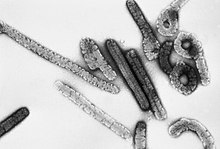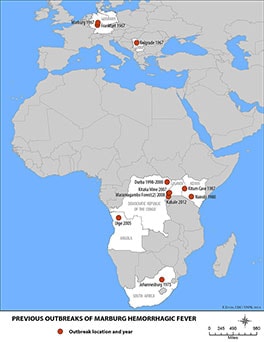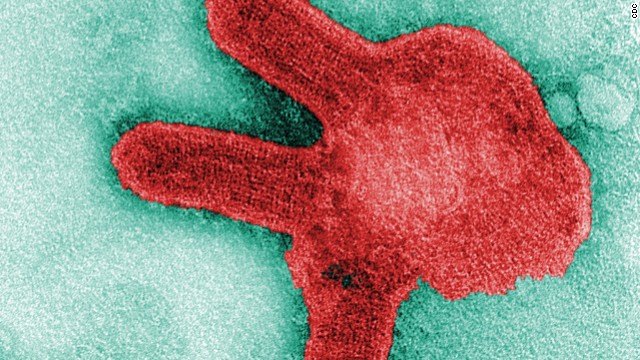Marburg virus (/ˈmÉ'rbÉ™rÉ¡ ˈvaɪrÉ™s/ MAR-bÉ™rg VY-rÉ™s) is a hemorrhagic fever virus of the Filoviridae family of viruses and a member of the species Marburg marburgvirus, genus Marburgvirus. Marburg virus (MARV) causes Marburg virus disease in humans and nonhuman primates, a form of viral hemorrhagic fever. Marburg virus was first noticed and described during small epidemics in the German cities Marburg and Frankfurt and the Yugoslav capital Belgrade in the 1960s. Workers were accidentally exposed to tissues of infected grivets (Chlorocebus aethiops) at the city's former main industrial plant, the Behringwerke, then part of Hoechst, and today of CSL Behring. During these outbreaks, 31 people became infected and seven of them died. MARV is a Select Agent, WHO Risk Group 4 Pathogen (requiring biosafety level 4-equivalent containment), NIH/National Institute of Allergy and Infectious Diseases Category A Priority Pathogen, Centers for Disease Control and Prevention Category A Bioterrorism Agent, and is listed as a biological agent for export control by the Australia Group.
Use of term

Marburg virus was first described in 1967. Today, the virus is one of two members of the species Marburg marburgvirus, which is included in the genus Marburgvirus, family Filoviridae, order Mononegavirales. The name Marburg virus is derived from Marburg (the city in Hesse, Germany, where the virus was first discovered) and the taxonomic suffix virus.
Note
According to the rules for taxon naming established by the International Committee on Taxonomy of Viruses (ICTV), the name Marburg virus is always to be capitalized, but is never italicized, and may be abbreviated (with MARV being the official abbreviation).
Previous designations

Marburg virus was first introduced under this name in 1967. In 2005, the virus name was changed to Lake Victoria marburgvirus, which unfortunately was the same spelling as its species Lake Victoria marburgvirus. However, most scientific articles continued to refer to Marburg virus. Consequently, in 2010, the name Marburg virus was reinstated and the species name changed. A previous abbreviation for the virus was MBGV.
Virus inclusion criteria

A virus that fulfills the criteria for being a member of the species Marburg marburgvirus is a Marburg virus if its genome diverges from that of the prototype Marburg marburgvirus, Marburg virus variant Musoke (MARV/Mus), by <10% at the nucleotide level.
Disease
MARV is one of two marburgviruses that causes Marburg virus disease (MVD) in humans (in the literature also often referred to as Marburg hemorrhagic fever, MHF). In the past, MARV has caused the following MVD outbreaks:
Virology

Genome
Like all mononegaviruses, marburgvirions contain non-infectious, linear nonsegmented, single-stranded RNA genomes of negative polarity that possesses inverse-complementary 3' and 5' termini, do not possess a 5' cap, are not polyadenylated, and are not covalently linked to a protein. Marburgvirus genomes are approximately 19 kb long and contain seven genes in the order 3'-UTR-NP-VP35-VP40-GP-VP30-VP24-L-5'-UTR. The genomes of the two different marburgviruses (MARV and RAVV) differ in sequence.
Structure
Like all filoviruses, marburgvirions are filamentous particles that may appear in the shape of a shepherd's crook or in the shape of a "U" or a "6", and they may be coiled, toroid, or branched. Marburgvirions are generally 80 nm in width, but vary somewhat in length. In general, the median particle length of marburgviruses ranges from 795 to 828 nm (in contrast to ebolavirions, whose median particle length was measured to be 974â€"1,086 nm ), but particles as long as 14,000 nm have been detected in tissue culture. Marburgvirions consist of seven structural proteins. At the center is the helical ribonucleocapsid, which consists of the genomic RNA wrapped around a polymer of nucleoproteins (NP). Associated with the ribonucleoprotein is the RNA-dependent RNA polymerase (L) with the polymerase cofactor (VP35) and a transcription activator (VP30). The ribonucleoprotein is embedded in a matrix, formed by the major (VP40) and minor (VP24) matrix proteins. These particles are surrounded by a lipid membrane derived from the host cell membrane. The membrane anchors a glycoprotein (GP1,2) that projects 7 to 10 nm spikes away from its surface. While nearly identical to ebolavirions in structure, marburgvirions are antigenically distinct.
Entry
Niemannâ€"Pick C1 (NPC1) appears to be essential for Ebola and Marburg virus infection. Two independent studies reported in the same issue of Nature (journal) showed that Ebola virus cell entry and replication requires the cholesterol transporter protein NPC1. When cells from patients lacking NPC1 were exposed to Ebola virus in the laboratory, the cells survived and appeared immune to the virus, further indicating that Ebola relies on NPC1 to enter cells. This might imply that genetic mutations in the NPC1 gene in humans could make some people resistant to one of the deadliest known viruses affecting humans. The same studies described similar results with Ebola's cousin in the filovirus group, Marburg virus, showing that it too needs NPC1 to enter cells. Furthermore, NPC1 was shown to be critical to filovirus entry because it mediates infection by binding directly to the viral envelope glycoprotein. A later study confirmed the findings that NPC1 is a critical filovirus receptor that mediates infection by binding directly to the viral envelope glycoprotein and that the second lysosomal domain of NPC1 mediates this binding.
In one of the original studies, a small molecule was shown to inhibit Ebola virus infection by preventing the virus glycoprotein from binding to NPC1. In the other study, mice that were heterozygous for NPC1 were shown to be protected from lethal challenge with mouse adapted Ebola virus. Together, these studies suggest NPC1 may be potential therapeutic target for an Ebola anti-viral drug.
Replication
The marburg virus life cycle begins with virion attachment to specific cell-surface receptors, followed by fusion of the virion envelope with cellular membranes and the concomitant release of the virus nucleocapsid into the cytosol. The virus RdRp partially uncoats the nucleocapsid and transcribes the genes into positive-stranded mRNAs, which are then translated into structural and nonstructural proteins. Marburgvirus L binds to a single promoter located at the 3' end of the genome. Transcription either terminates after a gene or continues to the next gene downstream. This means that genes close to the 3' end of the genome are transcribed in the greatest abundance, whereas those toward the 5' end are least likely to be transcribed. The gene order is therefore a simple but effective form of transcriptional regulation. The most abundant protein produced is the nucleoprotein, whose concentration in the cell determines when L switches from gene transcription to genome replication. Replication results in full-length, positive-stranded antigenomes that are in turn transcribed into negative-stranded virus progeny genome copies. Newly synthesized structural proteins and genomes self-assemble and accumulate near the inside of the cell membrane. Virions bud off from the cell, gaining their envelopes from the cellular membrane they bud from. The mature progeny particles then infect other cells to repeat the cycle.
Ecology

In 2009, the successful isolation of infectious MARV was reported from caught healthy Egyptian rousettes (Rousettus aegyptiacus). This isolation, together with the isolation of infectious RAVV, strongly suggests that Old World fruit bats are involved in the natural maintenance of marburgviruses. Further studies are necessary to establish whether Egyptian rousettes are the actual hosts of MARV and RAVV or whether they get infected via contact with another animal and therefore serve only as intermediate hosts. Recently the first experimental infection study of Rousettus aegyptiacus with MARV provided further insight into the possible involvement of these bats in MARV ecology. Experimentally infected bats developed relatively low viremia lasting at least 5 days, but remained healthy and didn't develop any notable gross pathology. The virus also replicated to high titers in major organs (liver and spleen), and organs that might possibly be involved in virus transmission (lung, intestine, reproductive organ, salivary gland, kidney, bladder and mammary gland). The relatively long period of viremia noted in this experiment could possibly also facilitate mechanical transmission by blood sucking arthropods or infection of susceptible vertebrate hosts by direct contact with infected blood.
Weaponization

The Soviet Union had an extensive offensive and defensive biological weapons program that included MARV. At least three Soviet research institutes had MARV research programs during offensive times: the Virology Center of the Scientific-Research Institute for Microbiology in Zagorsk (today Sergiev Posad), the Scientific-Production Association "Vektor" (today the State Research Center of Virology and Biotechnology "Vektor") in Koltsovo, and the Irkutsk Scientific-Research Anti-Plague Institute of Siberia and the Far East in Irkutsk. As most performed research was highly classified, it remains unclear how successful the MARV program was. However, Soviet defector Ken Alibek claimed that a weapon filled with MARV was tested at the Stepnogorsk Scientific Experimental and Production Base in Stepnogorsk, Kazakh Soviet Socialist Republic (today Kazakhstan), suggesting that the development of a MARV biological weapon had reached advanced stages. Independent confirmation for this claim is lacking. At least one laboratory accident with MARV, resulting in the death of Koltsovo researcher Nikolai Ustinov, occurred during offensive times in the Soviet Union and was first described in detail by Alibek. After the dissolution of the Soviet Union, MARV research continued in all three institutes.
Vaccine research

In 2009, expanded clinical trials of an Ebola and Marburg vaccine began in Kampala, Uganda. As of October 2014, no vaccine has been approved for use in the US.
In popular culture
- In the non-fiction thriller, The Hot Zone, Richard Preston describes several MARV infections
- In the 2008 Indian science fiction Movie 'Dasavathaaram' by Kamal Haasan, the plot is about an intended bio weapon of 'Ebola Marburg' virus.
- In the TV series Millennium, at the end of Season 2, a "prion version" of MARV causes a disease outbreak in Seattle, killing (amongst others) Frank Black's wife, Catherine. In the Season 3 episode Collateral Damage, Peter Watt's daughter is infected with MARV by a Gulf War veteran who claims that the Millennium Group did the same to American soldiers during the first Gulf War
- In the crossover event of the TV series Medical Investigation, episode 17, and Third Watch, season 6 episode 16, Marburg virus disease breaks out in New York City, killing 5 of 6 infected people
- In the Sarah Jane Smith series (Series Two), MARV is used as a weapon by a doomsday cult
- In the short story Hell Hath Enlarged Herself by Michael Marshall Smith, one of the original scientists is infected with MARV in an attempt to test ImmunityWorks ver. 1.0
- In the novel Microserfs by Douglas Coupland, MARV is mentioned several times as a metaphor for the spread of information through the internet
- In the novel Resident Evil: Caliban Cove, an insane scientist and former professor named Nicolas Griffith is referred to by Rebecca Chambers as having infected three men with MARV after they had been led to believe it was a harmless common cold virus
- In the novel Pandora's Legion by Harold Coyle and Barrett Tillman, an Al-Qaeda cell in Pakistan injects volunteers with MARV, who then board flights to major international airports in the western world where the large flow of people would facilitate the spreading of the virus into a pandemic.
- In the TV series Body of Proof, Season 2, episodes 18 and 19 include a MARV outbreak.
- In Mira Grant's novel Feed, a modified Marburg virus that cures cancer combines with a virally transmitted cure for the common cold, resulting in a virulent viral plague that turns infected humans and animals into zombies.
- Motaba, the fictional deadly viral hemorrhagic fever, in the movie Outbreak, is based on MARV
- In the video game Trauma Team, the seventh chapter of the game, named "Patient Zero", has a storyline of a mass outbreak of the fictional Rosalia Virus, which has similar symptoms to the Ebola Virus and Marburg Virus.
- In the episode "The Order 23 Job" of the TV show Leverage, the team's mark is led to believe that he is caught in an outbreak of weaponized Marburg virus made by the Soviets.
- In the episode "Death is in the Air" of the TV show Psych, the fictional Thornburg virus is based on the Marburg virus.
- In the episode "Small Sacrifices" of the TV show "House MD", the team explores Marburg as a diagnosis for a patient
- In the episode "The Promise" of the Canadian TV show ReGenesis Marburg was the subject of a War Games exercise and a weaponized strain out of a lab in South Africa poses a potential threat
- In the episode "Honor Among Thieves" of the TV show Person of Interest, the Marburg virus is shown to be used as a potential Bioterrorism agent to cause a pandemic starting in New York.
References
Further reading
External links
- International Committee on Taxonomy of Viruses (ICTV)
- FILOVIR - scientific resources for research on filoviruses







I was diagnosed of Herpes 2 years ago and I have tried all possible means to get the cure but all to no avail, until I saw a post in a health forum about a Herbal Doctor(Dr Akhigbe) who prepares herbal medicine to cure all kind of diseases including Herpes, at first i doubted, if it was real but decided to give him a trial, when I contacted Dr Akhigbe through his Email: drrealakhigbe@gmail.com he guided me and prepared a herbal medicine and sent it to me via courier Delivery service,when I received the package (herbal medicine) He gave me instructions on how to consume it,I started using it as instructed and I stopped getting outbreaks and the sores started vanishing, could you believe I was cured of this deadly virus within two to three weeks and notices changes in my body. Days of using this REMEDY,couldn't believe the healing at first until I see it as my HERPES get cleared like magic Dr Akhigbe also use his herbal medicine to cure diseases like, HIV, HERPES, CANCER, ALS, CHRONIC DISEASE, HEART DISEASE, LUPUS, ASTHMA, DIABETES, MARBURG VIRUS, HEPATITIS A AND B.ECZEMA, BACK PAIN, EXTERNAL INFECTION ,ASTHMA, MALARIA, DENGUE FEVER, BACTERIA DIARRHEA, RABIES, OBESITY, PROGERIA, MENINGITIS, EPILEPSY,STROKE, LYMPHEDEMA, GALLSTONE, PENIS EJACULATION, HPV, OSTEOPOROSIS, RHEUMATISM, THYROID, COLD & FLU,KIDNEY DISEASE,ACME. ERYSIPELAS. etc Contact this great herbal Doctor today the father of herbal root cure. via Email: drrealakhigbe@gmail.com or whatsapp him +2349010754824 and get cured permanently He is real..website: https:drrealakhigbe.weebly.com
ReplyDelete